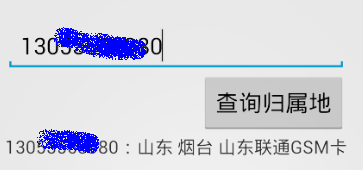編輯:Android資訊
okHttp: OKHttp是Android版Http客戶端。非常高效,支持SPDY、連接池、GZIP和 HTTP 緩存。默認情況下,OKHttp會自動處理常見的網絡問題,像二次連接、SSL的握手問題。如果你的應用程序中集成了OKHttp,Retrofit默認會使用OKHttp處理其他網絡層請求。
An HTTP & SPDY client for Android and Java applications 從Android4.4開始HttpURLConnection的底層實現采用的是okHttp.
使用要求:對於Android:2.3以上,對於Java:java7以上 兩個模塊: okhttp-urlconnection實現.HttpURLConnection API; okhttp-apache實現Apache HttpClient API. 依賴:okio(https://github.com/square/okio): Okio, which OkHttp uses for fast I/O and resizable buffers.
maven:
com.squareup.okhttpokhttp2.3.0
Gradle:
compile 'com.squareup.okhttp:okhttp:2.3.0'
private final OkHttpClient client = new OkHttpClient();
public void run() throws Exception {
Request request = new Request.Builder()
.url(http://publicobject.com/helloworld.txt)
.build();
Response response = client.newCall(request).execute();
if (!response.isSuccessful()) throw new IOException(Unexpected code + response);
Headers responseHeaders = response.headers();
for (int i = 0; i < responseHeaders.size(); i++) {
System.out.println(responseHeaders.name(i) + : + responseHeaders.value(i));
}
System.out.println(response.body().string());
}
在一個工作線程中下載文件,當響應可讀時回調Callback接口。讀取響應時會阻塞當前線程。OkHttp現階段不提供異步api來接收響應體。
private final OkHttpClient client = new OkHttpClient();
public void run() throws Exception {
Request request = new Request.Builder()
.url(http://publicobject.com/helloworld.txt)
.build();
client.newCall(request).enqueue(new Callback() {
@Override public void onFailure(Request request, Throwable throwable) {
throwable.printStackTrace();
}
@Override public void onResponse(Response response) throws IOException {
if (!response.isSuccessful()) throw new IOException(Unexpected code + response);
Headers responseHeaders = response.headers();
for (int i = 0; i < responseHeaders.size(); i++) {
System.out.println(responseHeaders.name(i) + : + responseHeaders.value(i));
}
System.out.println(response.body().string());
}
});
}
private final OkHttpClient client = new OkHttpClient();
public void run() throws Exception {
Request request = new Request.Builder()
.url(https://api.github.com/repos/square/okhttp/issues)
.header(User-Agent, OkHttp Headers.java)
.addHeader(Accept, application/json; q=0.5)
.addHeader(Accept, application/vnd.github.v3+json)
.build();
Response response = client.newCall(request).execute();
if (!response.isSuccessful()) throw new IOException(Unexpected code + response);
System.out.println(Server: + response.header(Server));
System.out.println(Date: + response.header(Date));
System.out.println(Vary: + response.headers(Vary));
}
public static final MediaType jsonReq
= MediaType.parse(application/json; charset=utf-8);
OkHttpClient client = new OkHttpClient();
String post(String url, String json) throws IOException {
RequestBody body = RequestBody.create(jsonReq, json);
Request request = new Request.Builder()
.url(url)
.post(body)
.build();
Response response = client.newCall(request).execute();
return response.body().string();
}
public static final MediaType MEDIA_TYPE_MARKDOWN
= MediaType.parse(text/x-markdown; charset=utf-8);
private final OkHttpClient client = new OkHttpClient();
public void run() throws Exception {
RequestBody requestBody = new RequestBody() {
@Override public MediaType contentType() {
return MEDIA_TYPE_MARKDOWN;
}
@Override public void writeTo(BufferedSink sink) throws IOException {
sink.writeUtf8(Numbers
);
sink.writeUtf8(-------
);
for (int i = 2; i <= 997; i++) {
sink.writeUtf8(String.format( * %s = %s
, i, factor(i)));
}
}
private String factor(int n) {
for (int i = 2; i < n; i++) {
int x = n / i;
if (x * i == n) return factor(x) + × + i;
}
return Integer.toString(n);
}
};
Request request = new Request.Builder()
.url(https://api.github.com/markdown/raw)
.post(requestBody)
.build();
Response response = client.newCall(request).execute();
if (!response.isSuccessful()) throw new IOException(Unexpected code + response);
System.out.println(response.body().string());
}
public static final MediaType MEDIA_TYPE_MARKDOWN
= MediaType.parse(text/x-markdown; charset=utf-8);
private final OkHttpClient client = new OkHttpClient();
public void run() throws Exception {
File file = new File(README.md);
Request request = new Request.Builder()
.url(https://api.github.com/markdown/raw)
.post(RequestBody.create(MEDIA_TYPE_MARKDOWN, file))
.build();
Response response = client.newCall(request).execute();
if (!response.isSuccessful()) throw new IOException(Unexpected code + response);
System.out.println(response.body().string());
}
private final OkHttpClient client = new OkHttpClient();
public void run() throws Exception {
RequestBody formBody = new FormEncodingBuilder()
.add(search, Jurassic Park)
.build();
Request request = new Request.Builder()
.url(https://en.wikipedia.org/w/index.php)
.post(formBody)
.build();
Response response = client.newCall(request).execute();
if (!response.isSuccessful()) throw new IOException(Unexpected code + response);
System.out.println(response.body().string());
}
private static final String IMGUR_CLIENT_ID = ...;
private static final MediaType MEDIA_TYPE_PNG = MediaType.parse(image/png);
private final OkHttpClient client = new OkHttpClient();
public void run() throws Exception {
// Use the imgur image upload API as documented at https://api.imgur.com/endpoints/image
RequestBody requestBody = new MultipartBuilder()
.type(MultipartBuilder.FORM)
.addPart(
Headers.of(Content-Disposition, form-data; name= itle),
RequestBody.create(null, Square Logo))
.addPart(
Headers.of(Content-Disposition, form-data; name=image),
RequestBody.create(MEDIA_TYPE_PNG, new File(website/static/logo-square.png)))
.build();
Request request = new Request.Builder()
.header(Authorization, Client-ID + IMGUR_CLIENT_ID)
.url(https://api.imgur.com/3/image)
.post(requestBody)
.build();
Response response = client.newCall(request).execute();
if (!response.isSuccessful()) throw new IOException(Unexpected code + response);
System.out.println(response.body().string());
}
private final OkHttpClient client = new OkHttpClient();
private final Gson gson = new Gson();
public void run() throws Exception {
Request request = new Request.Builder()
.url(https://api.github.com/gists/c2a7c39532239ff261be)
.build();
Response response = client.newCall(request).execute();
if (!response.isSuccessful()) throw new IOException(Unexpected code + response);
Gist gist = gson.fromJson(response.body().charStream(), Gist.class);
for (Map.Entry entry : gist.files.entrySet()) {
System.out.println(entry.getKey());
System.out.println(entry.getValue().content);
}
}
static class Gist {
Map files;
}
static class GistFile {
String content;
}
為了緩存響應,你需要一個你可以讀寫的緩存目錄,和緩存大小的限制。這個緩存目錄應該是私有的,不信任的程序應不能讀取緩存內容。
一個緩存目錄同時擁有多個緩存訪問是錯誤的。大多數程序只需要調用一次 new OkHttp() ,在第一次調用時配置好緩存,然後其他地方只需要調用這個實例就可以了。否則兩個緩存示例互相干擾,破壞響應緩存,而且有可能會導致程序崩潰。
響應緩存使用HTTP頭作為配置。你可以在請求頭中添加 Cache-Control: max-stale=3600 ,OkHTTP緩存會支持。你的服務通過響應頭確定響應緩存多長時間,例如使用 Cache-Control: max-age=9600 。
private final OkHttpClient client;
public CacheResponse(File cacheDirectory) throws Exception {
int cacheSize = 10 * 1024 * 1024; // 10 MiB
Cache cache = new Cache(cacheDirectory, cacheSize);
client = new OkHttpClient();
client.setCache(cache);
}
public void run() throws Exception {
Request request = new Request.Builder()
.url(http://publicobject.com/helloworld.txt)
.build();
Response response1 = client.newCall(request).execute();
if (!response1.isSuccessful()) throw new IOException(Unexpected code + response1);
String response1Body = response1.body().string();
System.out.println(Response 1 response: + response1);
System.out.println(Response 1 cache response: + response1.cacheResponse());
System.out.println(Response 1 network response: + response1.networkResponse());
}
final Call call = client.newCall(request);
call.cancel();
private final OkHttpClient client;
public ConfigureTimeouts() throws Exception {
client = new OkHttpClient();
client.setConnectTimeout(10, TimeUnit.SECONDS);
client.setWriteTimeout(10, TimeUnit.SECONDS);
client.setReadTimeout(30, TimeUnit.SECONDS);
}
private final OkHttpClient client = new OkHttpClient();
public void run() throws Exception {
client.setAuthenticator(new Authenticator() {
@Override public Request authenticate(Proxy proxy, Response response) {
System.out.println(Authenticating for response: + response);
System.out.println(Challenges: + response.challenges());
String credential = Credentials.basic(jesse, password1);
return response.request().newBuilder()
.header(Authorization, credential)
.build();
}
@Override public Request authenticateProxy(Proxy proxy, Response response) {
return null; // Null indicates no attempt to authenticate.
}
});
Request request = new Request.Builder()
.url(http://publicobject.com/secrets/hellosecret.txt)
.build();
Response response = client.newCall(request).execute();
if (!response.isSuccessful()) throw new IOException(Unexpected code + response);
System.out.println(response.body().string());
}
為避免當驗證失敗時多次重試,我們可以通過返回null來放棄驗證:
if (responseCount(response) >= 3) {
return null; // If we've failed 3 times, give up.
}
//添加以下方法
private int responseCount(Response response) {
int result = 1;
while ((response = response.priorResponse()) != null) {
result++;
}
return result;
}
class LoggingInterceptor implements Interceptor {
@Override public Response intercept(Chain chain) throws IOException {
Request request = chain.request();
long t1 = System.nanoTime();
logger.info(String.format(Sending request %s on %s%n%s,
request.url(), chain.connection(), request.headers()));
Response response = chain.proceed(request);
long t2 = System.nanoTime();
logger.info(String.format(Received response for %s in %.1fms%n%s,
response.request().url(), (t2 - t1) / 1e6d, response.headers()));
return response;
}
}
OkHttpClient client = new OkHttpClient(); client.interceptors().add(new LoggingInterceptor());
OkHttpClient client = new OkHttpClient(); client.networkInterceptors().add(new LoggingInterceptor());
 Android中使用Android Ksoap2調用WebService
Android中使用Android Ksoap2調用WebService
一、WebService介紹 WebService是基於SOAP協議可實現web服務器與web服務器之間的通信,因采用SOAP協議傳送XML數據具有平台無關性,也
 Android UI控件系列:DatePicker,TimePicker(日期和時間選擇)
Android UI控件系列:DatePicker,TimePicker(日期和時間選擇)
日期和時間是任何手機平台都有的功能,Android也如此。 DatePicker:用來實現日期(年月日) TimePicker:用來實現時間(時分秒) Calen
 在 Linux 上將 BQ Aquaris Ubuntu 手機刷成 Android 系統
在 Linux 上將 BQ Aquaris Ubuntu 手機刷成 Android 系統
如果你正好擁有全球第一支運行 Ubuntu 的手機並且希望將 BQ Aquaris E4.5 自帶的 Ubuntu 系統換成 Android,那這篇文章能幫你點小
 Android的官司打贏了 屬於Android社區的勝利
Android的官司打贏了 屬於Android社區的勝利
BI 中文站 5 月 27 日報道 美國陪審團裁決剛剛揭曉,根據此次最新的裁決,甲骨文在控訴谷歌侵權之爭中敗訴。陪審團認為,谷歌使用有爭議的代碼程序是“公平使用(